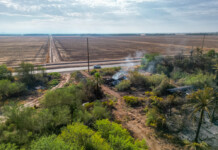
The California Zephyr car offered the latest in lavish accommodations and glass covered observation decks to train-traveling sightseers more than 50 years ago.
On Saturday, locals got a glimpse of the past when the Maricopa Historical Society opened the doors to Maricopa’s own Silver Horizon California Zephyr train car.
Inaugurated in 1949, the California Zephyr was built as a passenger line to take customers from Chicago to the San Francisco Bay, a route that covered 2,525 miles of track. Unique to other trains of the time, California Zephyr’s were built to give passengers scenic views as they made their journey across the country.
“This car is pretty much an observation car and lounge,” said Brent Murphree, president of the Maricopa Historical Society.
“It was a class service; the type of ticket you had would allow you access to certain areas. It’s kind of like the Titanic.”
Seven Zephyr trains ran the route and contained buffet lounges, diner cars, sleeper cars and multiple observation cars like Maricopa’s Silver Horizon.
“The Zephyrs are just neat trains from the past and show how people used to travel in style,” said historical society member Judi Shirk. “Art Deco is one of my favorites.”
The car, which never ran through Maricopa, was found in a junk pile and made its way to Maricopa in 2000 where it originally was used as the ticket booth for the Amtrak station.
“People from Maricopa, especially the ones who have grown up here, are very passionate about the city,” Shirk added.
The Silver Horizon, which is owned by Pinal County, isn’t in any immediate danger of losing its place in Maricopa; however, there are circumstances that could jeopardize its spot in the city.
The location of the train car could become part of the long-awaited grade separation that will route traffic over the train tracks that run adjacent to the Maricopa-Casa Grande Highway, Murphree said. This would mean a costly relocation of the car.
However, there is a more immediate issue.
“A potential threat is lack of funding and maintaining the train car. It looks great on the inside and we want it to look just as nice on the outside,” Murphree said. “We would love it if we could have someone come in like an Eagle Scout project and clean it up, and maybe do some minor restoration.”
The car doesn’t receive routine maintenance or any professional upkeep. Though renovations on the inside that were done before the car found its way to Maricopa remain pristine, the natural weathering and age deterioration remain a threat to the car’s shell.




![Maricopa’s ‘TikTok Rizz Party,’ explained One of several flyers for a "TikTok rizz party" is taped to a door in the Maricopa Business Center along Honeycutt Road on April 23, 2024. [Monica D. Spencer]](https://www.inmaricopa.com/wp-content/uploads/2024/04/spencer-042324-tiktok-rizz-party-flyer-web-218x150.jpg)



![Locals find zen with Earth Day drum circle Lizz Fiedorczyk instructs a drum circle at Maricopa Community Center April 22, 2024. [Brian Petersheim Jr.]](https://www.inmaricopa.com/wp-content/uploads/2024/04/PJ_3922-Enhanced-NR-218x150.jpg)




![Maricopa restauranteur makes Food Network connection [Namkeen Dhaba]](https://www.inmaricopa.com/wp-content/uploads/2024/04/439456716_377105198650519_7536248579664805896_n-100x70.jpg)


